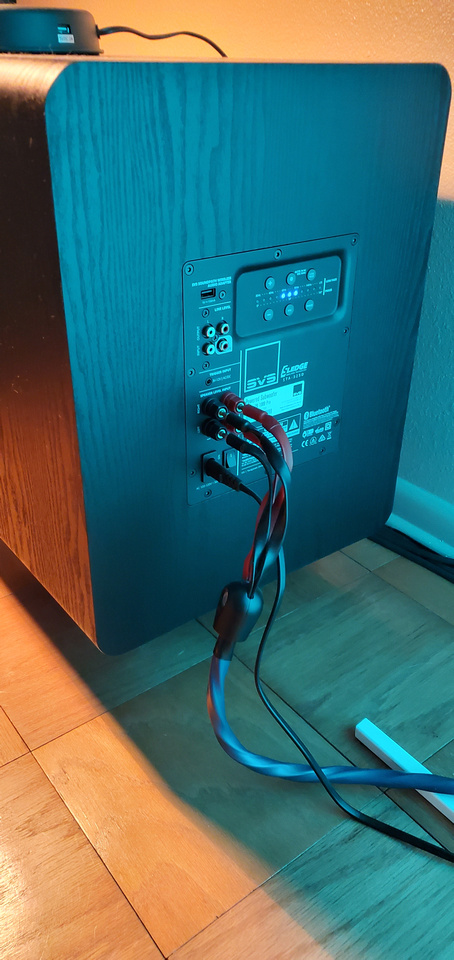I recently bought a pair of Maggie 3.7i's (and a Parasound A21+ amp and a Bluesound Node, streaming Tidal). These are, by far, the best sounding speakers I've EVER owned (and I've owned a bunch in my 60 years on this earth). But, they are - no surprise - severely lacking in bottom-end "oomph." So, I bought a Maggie bass panel (DWM). This helped with the lower midrange and upper bass (and even extended the lower bass slightly), but still failed to produce the bottom end I wanted. Spoiler alert: most music doesn't have a lot of sub-bass, but for those that do, it's imperative that your system can reproduce it. So, I starting asking around...
"Don't add a sub - it will ruin the 'tight' bass that your Maggies are known for!" was what everyone told me - even Magnepan. But, I thought that didn't make sense - unless the subwoofer was ALSO reproducing bass (instead of just sub-bass*). As long as I kept the bass frequencies out of the sub (let the 3.7i's do the bass), it should sound fine. That was my theory.
*Many people think a subwoofer goes down to 30Hz. No: that's where sub-bass begins!
Enter SVS (highly recommended!) I bought their "entry level" sub (model SB-1000 Pro) to "test my theory" with the plans to upgrade it if I was right. Well: I am so happy with it, I never upgraded it - there's no need to! I roll it off at 33Hz @ 24dB/octave and use the parametric EQ to boost 20Hz by 6dB. As such the -3dB downpoint is around 16Hz. (The proverbial "bottom octave: 16-32Hz).
This adds a deep, gut-rumbling bottom end to music - and in NO WAY diminishes the "open", "airy", "tight". "fast" (choose one) bass of the Maggies. On most (some) music, the sub does nothing. But play, for example, Yello's "Stay" with and without the sub and you'll never do it without again!
I was, in fact, planning on upgrading to the 20.7's, but the 3.7's are almost identical to the 20.7's in all but the bass panel area - something the sub MORE THAN makes up for. Save the $5000 and get a sub (I DID audition the 20.7's before stating this)
To all Maggie owners: try this - you'll never go back. Just be sure to roll off the sub quickly and sharply (min: 24dB) and low. 33Hz is just right for my system in my room - you'll need to experiment. The nice thing about the SVS (though not unique) is the app that lets you tailor rolloff frequency, slope and parametric EQ to fill in exactly what is needed and NO MORE.
"Don't add a sub - it will ruin the 'tight' bass that your Maggies are known for!" was what everyone told me - even Magnepan. But, I thought that didn't make sense - unless the subwoofer was ALSO reproducing bass (instead of just sub-bass*). As long as I kept the bass frequencies out of the sub (let the 3.7i's do the bass), it should sound fine. That was my theory.
*Many people think a subwoofer goes down to 30Hz. No: that's where sub-bass begins!
Enter SVS (highly recommended!) I bought their "entry level" sub (model SB-1000 Pro) to "test my theory" with the plans to upgrade it if I was right. Well: I am so happy with it, I never upgraded it - there's no need to! I roll it off at 33Hz @ 24dB/octave and use the parametric EQ to boost 20Hz by 6dB. As such the -3dB downpoint is around 16Hz. (The proverbial "bottom octave: 16-32Hz).
This adds a deep, gut-rumbling bottom end to music - and in NO WAY diminishes the "open", "airy", "tight". "fast" (choose one) bass of the Maggies. On most (some) music, the sub does nothing. But play, for example, Yello's "Stay" with and without the sub and you'll never do it without again!
I was, in fact, planning on upgrading to the 20.7's, but the 3.7's are almost identical to the 20.7's in all but the bass panel area - something the sub MORE THAN makes up for. Save the $5000 and get a sub (I DID audition the 20.7's before stating this)
To all Maggie owners: try this - you'll never go back. Just be sure to roll off the sub quickly and sharply (min: 24dB) and low. 33Hz is just right for my system in my room - you'll need to experiment. The nice thing about the SVS (though not unique) is the app that lets you tailor rolloff frequency, slope and parametric EQ to fill in exactly what is needed and NO MORE.


